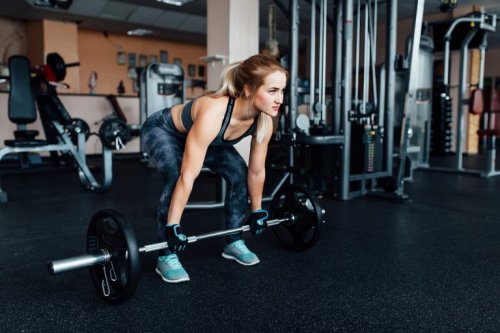3 Tips to Lift More Weight at The Gym Safely

Most athletes who go to the gym have an obsession with lifting more and more weight in their training. However, not all of them use their strength appropriately. Therefore, in this article, we’ll give you a few pointers to lift more weight at the gym.
The truth is that if you lift more weight, and increase the effort you’ll also increase muscle mass. However, weight lifting at the gym puts your back, shoulders, arms, and neck at risk of injury. Additionally, this risk is even higher with heavier weights.
When lifting weights, make sure that you’re using the correct techniques, this is critical. Therefore, not only will you obtain the results you’re looking for, but you’ll also avoid injuries. In any case, we also highly recommend stretching your muscles before and after each training session.
Likewise, remember to keep a healthy and balanced diet if your objective is to increase muscle mass. Thus, if you’re looking to lift more weight at the gym, you’ll find these next tips quite useful.
The best tips to lift more weight at the gym
1. Start with light weights
The first tip to lift more weight at the gym is to start out lifting lighter weights with slow movements. This will help you nail the proper techniques and movements. Then, with time, you’ll progress to heavier weights.
Consider that if you’re lifting more weight with incorrect movements and techniques, you’re putting your body at risk. Additionally, you can damage your body’s symmetry.

Likewise, when the weights are heavier, the movements have to be more precise. Therefore, with more weight, there’s a higher risk injury than with lower weights.
During this initial phase of strengthening, we recommend choosing a weight that allows you to easily do three repetitions. In other words, don’t give 100 percent of your effort in this phase.
Lifting weights and resistance training is an acquired skill. Therefore, you need to spend some time learning the correct way of doing it. In fact, most people don’t master this skill and don’t have the base to lift more weight at the gym.
However, with time, the movements and exercises become natural. Therefore, it’ll be a lot simpler to lift more weight at the gym.
2. Train often to lift more weight
Training frequently is one of the keys to achieving your goal of lifting higher weights at the gym. Try to work out between three and five times a week since more than that would be counterproductive to over exhaust yourself. Thus, you’ll be able to get better results.
In this preparation phase, you could, and should, include exercises such as squats, bench press, or deadlift. And so, the idea here is to do 3 to 6 series, and also between 3 and 6 repetitions.
3. Build muscle memory
The third and final tip that we’ve got for you today in order to lift more weight at the gym is to build muscle memory. The amount of weight you can lift also depends on the efficiency that your brain communicates with your muscles.

In other words, the faster your brain can coordinate with your muscles, the better you’ll be at lifting weights. This coordination includes your muscle groups directly targeted as well as supporting muscle groups.
Therefore, there’s a clear correlation between the amount of muscle we can activate and the amount of weight we lift. This means that the technique is quite important.
And so, remember that it doesn’t matter how many repetitions you’re doing, or how much weight you’re lifting. It’s important to feel that the last few repetitions are quite difficult to do, no matter how much weight you lift.
To sum up, we can conclude that establishing the appropriate technique is essential before increasing weight. Likewise, it’s vital to stretch before and after training to avoid possible injuries.
Most athletes who go to the gym have an obsession with lifting more and more weight in their training. However, not all of them use their strength appropriately. Therefore, in this article, we’ll give you a few pointers to lift more weight at the gym.
The truth is that if you lift more weight, and increase the effort you’ll also increase muscle mass. However, weight lifting at the gym puts your back, shoulders, arms, and neck at risk of injury. Additionally, this risk is even higher with heavier weights.
When lifting weights, make sure that you’re using the correct techniques, this is critical. Therefore, not only will you obtain the results you’re looking for, but you’ll also avoid injuries. In any case, we also highly recommend stretching your muscles before and after each training session.
Likewise, remember to keep a healthy and balanced diet if your objective is to increase muscle mass. Thus, if you’re looking to lift more weight at the gym, you’ll find these next tips quite useful.
The best tips to lift more weight at the gym
1. Start with light weights
The first tip to lift more weight at the gym is to start out lifting lighter weights with slow movements. This will help you nail the proper techniques and movements. Then, with time, you’ll progress to heavier weights.
Consider that if you’re lifting more weight with incorrect movements and techniques, you’re putting your body at risk. Additionally, you can damage your body’s symmetry.

Likewise, when the weights are heavier, the movements have to be more precise. Therefore, with more weight, there’s a higher risk injury than with lower weights.
During this initial phase of strengthening, we recommend choosing a weight that allows you to easily do three repetitions. In other words, don’t give 100 percent of your effort in this phase.
Lifting weights and resistance training is an acquired skill. Therefore, you need to spend some time learning the correct way of doing it. In fact, most people don’t master this skill and don’t have the base to lift more weight at the gym.
However, with time, the movements and exercises become natural. Therefore, it’ll be a lot simpler to lift more weight at the gym.
2. Train often to lift more weight
Training frequently is one of the keys to achieving your goal of lifting higher weights at the gym. Try to work out between three and five times a week since more than that would be counterproductive to over exhaust yourself. Thus, you’ll be able to get better results.
In this preparation phase, you could, and should, include exercises such as squats, bench press, or deadlift. And so, the idea here is to do 3 to 6 series, and also between 3 and 6 repetitions.
3. Build muscle memory
The third and final tip that we’ve got for you today in order to lift more weight at the gym is to build muscle memory. The amount of weight you can lift also depends on the efficiency that your brain communicates with your muscles.

In other words, the faster your brain can coordinate with your muscles, the better you’ll be at lifting weights. This coordination includes your muscle groups directly targeted as well as supporting muscle groups.
Therefore, there’s a clear correlation between the amount of muscle we can activate and the amount of weight we lift. This means that the technique is quite important.
And so, remember that it doesn’t matter how many repetitions you’re doing, or how much weight you’re lifting. It’s important to feel that the last few repetitions are quite difficult to do, no matter how much weight you lift.
To sum up, we can conclude that establishing the appropriate technique is essential before increasing weight. Likewise, it’s vital to stretch before and after training to avoid possible injuries.
All cited sources were thoroughly reviewed by our team to ensure their quality, reliability, currency, and validity. The bibliography of this article was considered reliable and of academic or scientific accuracy.
- Pastor Navarro, F. J. (2009). El entrenamiento de la fuerza en niños y jóvenes. Aplicación al rendimiento deportivo. Journal of Human Sport and Exercise, 2(1), 1–9. https://doi.org/10.4100/jhse.2007.21.01
- García Sánchez, I., & Requena Sánchez, B. (2012). La repetición máxima en el ejercicio de sentadilla: procedimientos de medida y factores determinantes. Apunts Educación Física y Deportes, (104), 96–105. https://doi.org/10.5672/apunts.2014-0983.es.(2011/2).104.10
- Oscár Morán Esquerdo. Enciclopedia de ejercicios de musculación. Recuperado de: https://www.realfitness.cl/admin/imagenes/descargas/Enciclopedia%20de%20ejercicios%20de%20musculacion.pdf
This text is provided for informational purposes only and does not replace consultation with a professional. If in doubt, consult your specialist.








